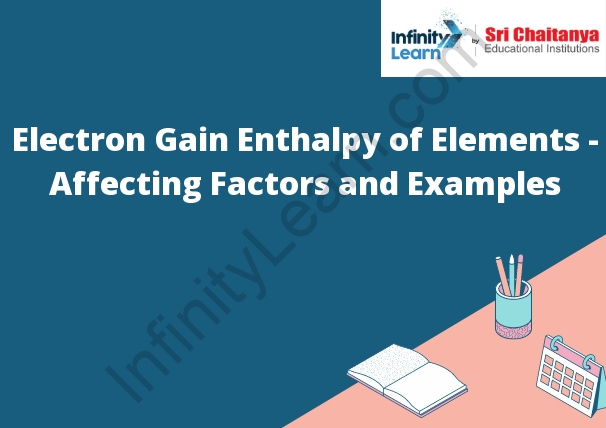What is Electron Gain Enthalpy of Elements?
The Electron Gain Enthalpy of an element is the enthalpy change that occurs when an electron is added to a gaseous atom of the element.

The electron gain enthalpy (EGA) of an element is a measure of how easily the element gains electrons. The higher the EGA, the more easily the element gains electrons. The EGA is important because it helps to determine how easily an element can form compounds.
The EGA of an element can be determined experimentally by measuring the enthalpy change that occurs when the element gains electrons. The enthalpy change can be determined by measuring the heat energy that is released or absorbed when the element gains electrons.
The electron gain enthalpy of an element can also be calculated theoretically by using the electron affinity of the element. The electron affinity is the amount of energy that is released when an electron is added to an atom of the element.
Factors affecting Electron Gain Enthalpy of Elements
The electron gain enthalpy of an element is a measure of the energy change that occurs when an atom in the gaseous state gains an electron to form a negatively charged ion. Several factors can affect the electron gain enthalpy of elements:
- Atomic Size: The size of the atom plays a significant role in determining electron gain enthalpy. Smaller atoms have higher electron gain enthalpies because the added electron experiences a stronger attraction from the nucleus. As the atomic size increases, the electron gain enthalpy decreases because the incoming electron is farther from the nucleus and experiences weaker attractive forces.
- Nuclear Charge: The number of protons in the nucleus affects the electron gain enthalpy. Elements with a higher nuclear charge (greater number of protons) have a stronger attraction for the incoming electron, leading to higher electron gain enthalpies.
- Electron Configuration: The stability of the electron configuration also influences the electron gain enthalpy. Elements with a stable electron configuration, such as noble gases, have high ionization energies and less tendency to gain electrons. They exhibit low or even negative electron gain enthalpies because the addition of an electron would result in an unfavorable electron configuration.
- Electron Repulsion: Electron-electron repulsion affects the electron gain enthalpy. When an electron is added to an atom, it enters an already occupied electron shell and experiences repulsive forces from the existing electrons. This electron-electron repulsion makes it more difficult to add an electron and decreases the electron gain enthalpy.
- Subshell Stability: The stability of partially filled or completely filled subshells can influence the electron gain enthalpy. Elements with partially filled subshells may have higher electron gain enthalpies to achieve a more stable configuration. For example, halogens (Group 17) have a strong tendency to gain an electron to achieve a stable noble gas electron configuration.
- Electron Affinity: The electron affinity of an element, which is the energy change associated with the addition of an electron to a neutral atom, is related to the electron gain enthalpy. Higher electron affinities generally correspond to higher electron gain enthalpies.
It is important to note that while these factors provide a general understanding of the trends in electron gain enthalpy across the periodic table, exceptions and anomalies can occur due to complex electronic and atomic interactions.
Examples of Electron Gain Enthalpy
Here are a few examples of electron gain enthalpy values for selected elements:
- Fluorine (F): Electron gain enthalpy of fluorine is -328 kJ/mol. Fluorine has a strong tendency to gain an electron to achieve a stable noble gas electron configuration.
- Chlorine (Cl): Electron gain enthalpy of chlorine is -349 kJ/mol. Chlorine, like fluorine, belongs to the halogen group and has a high affinity for gaining an electron.
- Oxygen (O): Electron gain enthalpy of oxygen is -141 kJ/mol. Oxygen also has a relatively high electron gain enthalpy due to its tendency to achieve a stable electron configuration by gaining two electrons.
- Nitrogen (N): Electron gain enthalpy of nitrogen is -7 kJ/mol. Nitrogen has a comparatively low electron gain enthalpy because it already has a stable half-filled p orbital configuration.
- Lithium (Li): Electron gain enthalpy of lithium is +60 kJ/mol. Unlike the aforementioned elements, lithium is a metal and tends to lose electrons rather than gain them. Therefore, its electron gain enthalpy is positive.
These examples demonstrate the varying magnitudes and directions (positive or negative) of electron gain enthalpies for different elements, highlighting the influence of factors such as atomic size, electron configuration, and stability on the tendency to gain electrons.





